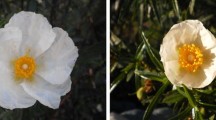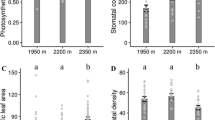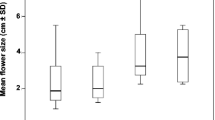Abstract
Larger flowers greatly increase among-individual pollen exchange within populations. However, water costs associated to transpirational cooling also increase with increasing flower size. Overall, the interplay between pollen and resource limitation determines the intensity of selection on flower size and this process is mostly dependent on gender and ecological context. To examine how pollinators and water use affect flower size, we determined corolla transpiration, pollen limitation, and selection through male and female fitness in two Kielmeyera species from the Brazilian cerrado flowering at different seasons. Hand-pollination experiments suggested pollen limitation through female fitness in both species, but K. coriacea showed lower limitation levels than K. regalis. For male fitness, the percentage of pollen removal was 1.5-times higher in K. coriacea. Higher air temperature and water deficit during flowering season of K. coriacea resulted in 4-fold higher corolla transpiration rates compared to K. regalis. Selection on flower size through male function was positive and significantly higher than selection through female components in both species. We also detected stabilizing selection in K. coriacea and positive selection in K. regalis on flower size through seed number. Our results suggest that selection on flower size in K. coriacea was mainly limited by water, whereas in K. regalis it was more limited by pollen. We demonstrate that differences in pollen and abiotic resource limitation determine gender-specific selection on flower size.


Similar content being viewed by others
References
Alvares CA, Stape JL, Sentelhas PC, de Moraes Gonçalves JL, Sparovek G (2013) Köppen’s climate classification map for Brazil. Meteorol Z 22:711–728
Arista M, Ortiz PL (2007) Differential gender selection on floral size: an experimental approach using Cistus salviifolius. J Ecol 95:973–982
Ashman T-L, Morgan MT (2004) Explaining phenotypic selection on plant attractive characters: male function, gender balance or ecological context? Proc R Soc Lond B Biol Sci 271:553–559
Barrio M, Teixido AL (2015) Sex-dependent selection on flower size in a large-flowered Mediterranean species: an experimental approach with Cistus ladanifer. Plant Syst Evol 301:113–124
Barros MA (2002) Floração sincrônica e sistemas reprodutivos em quatro espécies de Kielmeyera Mart. (Guttiferae). Acta Bot Bras 16:113–122
Bateman AJ (1948) Intra-sexual variation in Drosophila. Heredity 2:349–368
Bates D, Maechler M, Bolker B, Walker S (2015) Fitting linear mixed-effects models using lme4. J Stat Softw 67:1–48
Brito VLG, Maia FR, Silveira FAO, Fracasso CM, Lemos-Filho JP, Fernandes GW, Goldenberg R et al (2017) Reproductive phenology of Melastomataceae species with contrasting reproductive systems: contemporary and historical drivers. Plant Biol 19:806–817
Campbell DR, Powers JM (2015) Natural selection on floral morphology can be influenced by climate. Proc R Soc Lond B Biol Sci 282:20150178
Caruso CM, Remington DLD, Ostergren KE (2005) Variation in resource limitation of plant reproduction influences natural selection on floral traits of Asclepias syriaca. Oecologia 146:68–76
Chapman T (2006) Evolutionary conflicts of interest between males and females. Curr Biol 16:744–754
Chapotin SM, Holbrook NM, Morse SR, Gutiérrez MV (2003) Water relations of tropical dry forest flowers: pathways for water entry and the role of extracellular polysaccharides. Plant Cell Environ 26:623–630
Conner JK (2006) Ecological genetics of floral evolution. In: Harder LD, Barrett SCH (eds) Ecology and evolution of flowers. Oxford University Press, Oxford, pp 260–277
Cresswell JE (1998) Stabilizing selection and the structural variability of flowers within species. Ann Bot 81:463–473
Cruden RW, Lyon DL (1985) Patterns of biomass allocation to male and female functions in plants with different mating system. Oecologia 66:299–306
Fenster CB, Armbruster WS, Wilson P, Dudash MR, Thomson JD (2004) Pollination syndromes and floral specialization. Annu Rev Ecol Evol Syst 35:375–403
Galen C (1996) Rates of floral evolution: adaptation to bumblebee pollination in an alpine wildflower, Polemonium viscosum. Evolution 50:120–125
Galen C (1999) Why do flowers vary? The functional ecology of variation in flower size and form within natural plant populations. BioScience 49:631–640
Galen C (2005) It never rains but then it pours: the diverse effects of water on flower integrity and function. In: Reekie E, Bazzaz FA (eds) Reproductive allocation in plants. Elsevier Academic Press, San Diego, pp 75–95
Galen C, Dawson TE, Stanton ML (1993) Carpels as leaves: meeting the carbon cost of reproduction in an alpine buttercup. Oecologia 95:187–193
Galen C, Sherry RA, Carroll AB (1999) Are flowers physiological sinks or faucets? Costs and correlates of water use by flowers of Polemonium viscosum. Oecologia 118:461–470
Gallagher MK, Campbell DR (2017) Shifts in water availability mediate plant-pollinator interactions. New Phytol 215:792–802
Herrera CM (1993) Selection on floral morphology and environmental determinants of fecundity in a hawk moth-pollinated violet. Ecol Monogr 63:251–275
Hodgins KA, Barrett SCH (2008) Natural selection on floral traits through male and female function in wild populations of the heterostylous daffodil Narcissus triandrus. Evolution 62:1751–1763
Holland JN, Bronstein JL, DeAngelis DL (2004) Testing hypotheses for excess flower production and low fruit-to-flower ratios in a pollinating seed-consuming mutualism. Oikos 105:633–640
Knight TM, Steets JA, Vamosi JC, Mazer SJ, Burd M, Campbell DR, Dudash MR et al (2005) Pollen limitation of plant reproduction: pattern and process. Annu Rev Ecol Evol Syst 36:467–497
Köppen W (1900) Versuch einer klassifikation der klimate, vorzugsweise nach ihren beziehungen zur pflanzenwelt. Geogr Z 6:593–611
Lande R, Arnold SJ (1983) The measurement of selection on correlated characters. Evolution 37:1210–1226
Maad J, Alexandersson R (2004) Variable selection in Platanthera bifolia (Orchidaceae): phenotypic selection differed between sex functions in a drought year. J Evol Biol 17:642–650
Montalvo AM, Ackerman JD (1987) Limitations to fruit production in Ionopsis utricularioides (Orchidaceae). Biotropica 19:24–31
Nobel PS (2009) Physicochemical and environmental plant physiology. Elsevier Academic Press, Toronto
Nobel PS, De La Barrera E (2000) Carbon and water balances for young fruits of platyopuntias. Physiol Plant 109:160–166
Oliveira PE, Sazima M (1990) Pollination biology of two species of Kielmeyera (Guttiferae) from Brazilian cerrado vegetation. Plant Syst Evol 172:35–49
Oliveira PE, Silva JCS (1993) Reproductive biology of two species of Kielmeyera (Guttiferae) in the cerrados of Central Brazil. J Trop Ecol 9:67–79
Patiño S, Grace J (2002) The cooling of convolvulaceous flowers in a tropical environment. Plant Cell Environ 25:41–51
Peters J, Lanham B (2005) Tetrazolium testing handbook: contribution no. 29 to the handbook on seed testing. The Tetrazolium Subcommittee of the Association of Official Seed Analysts
R Development Core Team (2016) R: a language and environment for statistical computing. R Foundation for Statistical Computing, Vienna, Austria. https://www.R-project.org/
Ranieri BD, Negreiros D, Lana TC, Pezzini FF, Fernandes GW (2012) Fenologia reprodutiva, sazonalidade e germinação de Kielmeyera regalis (Clusiaceae), espécie endêmica dos campos rupestres da Cadeia do Espinhaço, Brasil. Acta Bot Bras 26:632–641
Saddi N (1987) New species of Kielmeyera (Guttiferae) from Brazil. Kew Bull 42:221–230
Sahli HF, Conner JK (2011) Testing for conflicting and nonadditive selection: floral adaptation to multiple pollinators through male and female fitness. Evolution 65:1457–1473
Sandring S, Ågren J (2009) Pollinator-mediated selection on floral display and flowering time in the perennial herb Arabidopsis lyrata. Evolution 63:1292–1300
Snow AA, Lewis PO (1993) Reproductive traits and male fertility in plants: empirical approaches. Annu Rev Ecol Syst 24:331–351
Stanton ML, Snow AA, Handel SN (1986) Floral evolution: attractiveness to pollinators increases male fitness. Science 232:1625–1627
Stinchcombe JR, Agrawal AF, Hohenlohe PA, Arnold SJ, Blows MW (2008) Estimating nonlinear selection gradients using quadratic regression coefficients: double or nothing? Evolution 62:2435–2440
Strauss SY, Whittall JB (2006) Non-pollinator agents of selection on floral traits. In: Harder LD, Barrett SCH (eds) Ecology and evolution of flowers. Oxford University Press, Oxford, pp 120–138
Teixido AL, Valladares F (2013) Large and abundant flowers increase indirect costs of corollas: a study of coflowering sympatric Mediterranean species of contrasting flower size. Oecologia 173:73–81
Teixido AL, Valladares F (2014) Disproportionate carbon and water maintenance costs of large corollas in hot Mediterranean ecosystems. Perspect Plant Ecol 16:83–92
Teixido AL, Barrio M, Valladares F (2016) Size matters: understanding the conflict faced by large flowers in Mediterranean environments. Bot Rev 82:204–228
Totland Ø (2001) Environment-dependent pollen limitation and selection on floral traits in an alpine species. Ecology 82:2233–2244
Wright JW, Meagher TR (2004) Selection on floral characters in natural Spanish populations of Silene latifolia. J Evol Biol 17:382–395
Acknowledgements
We thank two anonymous reviewers and T. Guerra for the suggestions provided to the text; J.P. Lemos-Filho for logistic support; G.W. Fernandes for providing us climatic data; F.S. Neves for statistical advice; and I. Gélvez, G. Gélvez, and C. Cavalcante for fieldwork assistance. A.L.T., A.J.A., and R.L.C.D. received a post-graduate scholarship from CAPES. L.A.O., J.V.S.M., and P.A.J. received a scientific initiation from FAPEMIG. F.A.O.S. received a productivity grant from CNPq. The data used in this study are archived at the figshare digital repository (https://doi.org/10.6084/m9.figshare.5435107.v1).
Author information
Authors and Affiliations
Corresponding author
Additional information
Communicated by Philip Ladd.
Electronic supplementary material
Below is the link to the electronic supplementary material.
Rights and permissions
About this article
Cite this article
Teixido, A.L., Dayrell, R.L.C., Arruda, A.J. et al. Differential gender selection on flower size in two Neotropical savanna congeneric species. Plant Ecol 219, 89–100 (2018). https://doi.org/10.1007/s11258-017-0780-4
Received:
Accepted:
Published:
Issue Date:
DOI: https://doi.org/10.1007/s11258-017-0780-4




